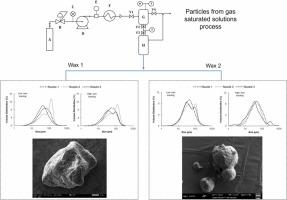工艺条件对菲托蜡PGSS微粉化的影响
IF 4.4
3区 工程技术
Q2 CHEMISTRY, PHYSICAL
引用次数: 0
摘要
通过气体饱和溶液工艺(PGSS)的颗粒,成功地进行了两种熔融温度不同的费托蜡(蜡1 <;蜡2)的微粉化。研究了压力、温度、蜡量和喷嘴类型对颗粒尺寸、形貌和容重的影响。增加的蜡载荷增加了颗粒大小,降低了对压力和温度变化的敏感性。喷嘴直径对粒径影响不大,喷嘴形状对粒径影响较大。在低压和低温下观察到双峰型粒度分布。蜡2由于延迟凝固而在低压和高温下形成球形、无孔颗粒。微粉化可减小片层尺寸,但对晶体结构影响不大。随着时间的推移,蜡2比蜡1显示出更大的晶体稳定性。结果表明,PGSS工艺参数,特别是温度和喷嘴形状,会影响蜡颗粒特性,为优化工业应用中的微粉化策略提供关键见解。本文章由计算机程序翻译,如有差异,请以英文原文为准。

The impact of processing conditions on PGSS micronisation of Fischer-Tropsch waxes
Micronisation of two Fischer-Tropsch waxes with differing melting temperatures (Wax 1 <Wax 2) via the particles from gas saturated solutions process (PGSS) was successfully performed. The impact of pressure, temperature, wax loading and nozzle type on particle size, morphology and bulk density was investigated. Increased wax loading increased particle size and reduced sensitivity to changes in pressure and temperature. Nozzle diameter did not impact particle size greatly, but nozzle shape did. Bimodal particle size distributions were observed at low pressure and low temperatures. Wax 2 formed spherical, non-porous particles at low pressure and high temperature due to delayed solidification. Micronisation reduced lamellar size but had little effect on crystal structure. Wax 2 showed greater crystal stability over time than Wax 1. The results demonstrate that PGSS process parameters, particularly temperature and nozzle shape, influence wax particle characteristics, providing critical insights for optimising micronisation strategies in industrial applications.
求助全文
通过发布文献求助,成功后即可免费获取论文全文。
去求助
来源期刊

Journal of Supercritical Fluids
工程技术-工程:化工
CiteScore
7.60
自引率
10.30%
发文量
236
审稿时长
56 days
期刊介绍:
The Journal of Supercritical Fluids is an international journal devoted to the fundamental and applied aspects of supercritical fluids and processes. Its aim is to provide a focused platform for academic and industrial researchers to report their findings and to have ready access to the advances in this rapidly growing field. Its coverage is multidisciplinary and includes both basic and applied topics.
Thermodynamics and phase equilibria, reaction kinetics and rate processes, thermal and transport properties, and all topics related to processing such as separations (extraction, fractionation, purification, chromatography) nucleation and impregnation are within the scope. Accounts of specific engineering applications such as those encountered in food, fuel, natural products, minerals, pharmaceuticals and polymer industries are included. Topics related to high pressure equipment design, analytical techniques, sensors, and process control methodologies are also within the scope of the journal.
 求助内容:
求助内容: 应助结果提醒方式:
应助结果提醒方式:


